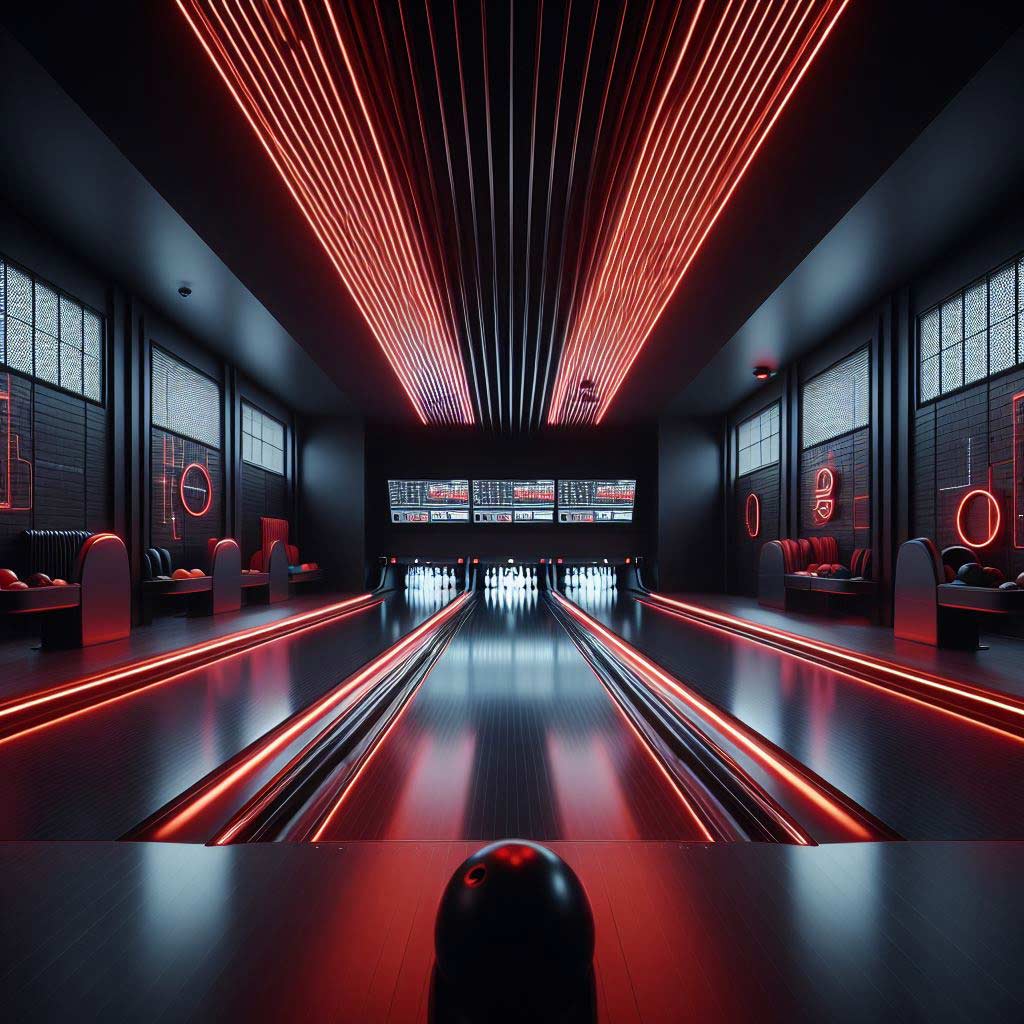Bowling alleys occupy a unique place in the American entertainment landscape. For generations, they have been beloved community hubs – places to gather for recreation, friendly competition, birthday parties, and more.
The architecture and design of traditional bowling centers have several trademark features that make them instantly recognizable. Long, straight lanes with scoring systems and seating areas.
Bright neon signs advertising beer specials or open play times. Walls lined with balls of varied sizes, weights, and colors. Music plays over the crash of pins and balls careening down the polished wooden pathway.
But one key element is conspicuously missing from most bowling alley constructions, especially in contrast to many other entertainment venues. Windows letting in natural daylight or allowing those on the outside a peek at the action within.
Why is it that the vast majority of dedicated bowling facilities seem to completely lack windows and outside visibility? As it turns out, there are some very interesting reasons behind this bit of curious bowling alley architecture.
The Evolution of Bowling Alley Design
To understand why contemporary bowling centers tend to have a closed-off, windowless design, it helps to know a bit about the history of bowling lane construction.
Bowling traces its early origins all the way back to Ancient Egypt and the Roman Empire. In Europe during the Middle Ages, primitive forms of bowling became popular pastimes, with informal lanes set up outdoors or in large halls within castles or monasteries.
When bowling first began gaining widespread appeal in the United States during the 1800s and early 1900s, alley constructions mimicked their ancestral counterparts.
Early American bowling facilities were often situated in basements or long hallways, sometimes with skylights or exterior windows allowing natural light and fresh air circulation.
These early bowling establishments had a social, egalitarian atmosphere. Patrons came dressed in their street clothes while they ate, drank, bowled, and mingled in unrestrained revelry.
As the sport began to take on a more competitive and professionalized flavor in the mid-1900s however, serious bowlers called for regulation lane conditions to foster fair play. Standardization required controlling variables like lighting, visibility, distractions, and atmosphere.
Thus began the evolutionary path to fully indoor, self-contained bowling lanes that looked inward rather than outward, carefully engineered environments providing ideal scoring conditions.
Precise Lighting Consistency is Vital
Perhaps one of the most compelling reasons behind the signature windowless constructions of most modern bowling alleys comes down to lighting.
Consistent, even, and well-diffused overhead lighting along the entire length of bowling lanes is hugely important for professional bowling competitions and serious league play.
Unlike uneven natural light which changes by time of day, artificial lights can be calibrated to exacting uniform standards. This helps create balanced visibility so players can accurately gauge ball speed, rotations, and pin action from one section of the lane to the next.
Uneven light conditions becoming obscured by shadows, glare patches, or brightness fluctuations can significantly impede competitive integrity and scoring consistency. When architectural designs incorporate large exterior windows, the lighting variability can undermine precision and satisfaction.
That helps explain why dedicated bowling centers engineered for avid hobbyists or professionals typically enclose the lanes entirely within a light-controlled shell. The predictability promotes fairness and fun across the bowling experience.
Avoiding External Distractions
Another benefit of windowless constructions relates to minimizing external distractions. Floor-to-ceiling windows allow in plenty of natural sunlight, but can also compromise the atmosphere bowling centers aim to foster.
Part of the appeal of traditional bowling alleys is entering a hive of recreational activity removed from outside stimuli. Once inside the cocoon of the bowling lounge, people can better focus attention on playing the game rather than incidental sights and sounds seeping in from the external environment.
Architectural elements like small high-set windows or decorative glass brick let in some natural light, yet don’t pull the eye towards lawnmowers roaring by or cars cruising through the parking lot.
Enclosed buildings allow bowlers to get into a focused, competitive mindset amid the intentional ambient noises of crashes, banter, and music.
By blocking views and buffering noise, the signature windowless constructions strip away diversions so bowlers can narrow full sensory attention on rolling strikes.
Creative Freedom for Atmosphere and Decor
Beyond technical considerations around optimal lighting and distraction buffers, the enclosed architecture of traditional bowling centers also serves some aesthetic design purposes.
The absence of outside windows and views enables virtually endless creativity options when it comes to decor themes, interior landscaping, and atmospheric engineering. Designers can fully control the sensory experience through elements like:
- Interior color palettes
- Light installations
- Decor props and faux building facades
- Sound system capabilities
- Special effects like fog, disco balls, and laser shows
Many beloved bowling alleys across America immerse visitors in far-flung adventure locales or nostalgia-steeped retro diners through every design detail.
Without having to incorporate unmovable exterior windows, interior designers enjoy great artistic liberty. Just as movie theaters create transportive environments through projected fantasies, bowling lanes can construct eye-catching mini worlds all their own behind closed walls.
Operational Savings from Eliminated Window Maintenance
An added benefit stemming from the signature windowless construction of bowling alleys comes by way of operational savings. Eliminating vast tracks of exterior glass translates into significantly reduced repair, cleaning, and general maintenance requirements.
Windows bring plenty of natural light and curb appeal, but also constant upkeep headaches. Inclement weather eventually causes leaks, frame wear, cracked panes, and other glitches needing professional attention. Meanwhile dirty windows mar visibility and the customer experience if left unaddressed.
By foregoing sizeable window installations, bowling centers slash expenses associated with window washing, wobbly air seals, storm damage, sun-fading, and additional utility costs for heating or cooling leaks.
The savings from minimized maintenance needs mean more budget can be invested into perfecting the bowling and entertainment experience rather than wasted battling window repairs. Yet one more reason the construction model has endured decade after decade.
Changing Lanes – Creative Innovations for Modern Bowling Alleys
Despite decades of clinging to tried-and-true architectural formulas, some daring bowling alley owners have recently begun bucking tradition through innovative new construction styles and striking designs:
Boutique Bowling Brands
While the lack of windows provides many benefits for traditional bowling centers, a crop of boutique hipster bowling joints have developed a cult following by taking the exact opposite approach.
Brands like The Gutter, Fubar, and Punch Bowl Social construct Instagram-worthy modern alley environments featuring brick walls graffitied with edgy art, tall industrial windows ushering in sunlight, and mixologist bars creating a chic, lofty atmosphere. Patrons flock for upscale recreation complete with posh furnishings and skyline views.
Outdoor Bowling Greens
Along with boutique indoor alley offshoots welcoming natural light, some facilities now integrate outdoor bowling components for vacation-esque recreation.
Newer family entertainment zones blend miniature golf, patio bars, water activities, and ample al fresco seating surrounding uncovered outdoor bowling greens. Visitors can bowl barefoot on manicured turf under sunny skies or starry nights.
High Tech Innovations
Rather than fully discarding traditional construction conventions, however, many modern bowling brands opt to preserve the conventional enclosed architecture while infusing next-generation technologies.
Blacklight bowling with glowing lanes, boutique bowling concepts housed in repurposed industrial buildings, avant-garde interior design elements, interactive projection mapping visuals, and augmented reality gaming represent exciting reinventions of classic bowling alley construction models rather than outright rebellion. Expect even more boundary-pushing bowling innovations in years ahead while the core foundations hold steady.
The Timeless Charm of Classic Bowling Alley Construction
So why don’t traditional bowling alleys incorporate windows or outside views in their signature construction blueprints?
In short: controlling lighting consistently, minimizing external distractions, maximizing design flexibility, and reducing operational costs. The enclosed architecture supports precision gameplay while allowing creativity to run wild.
While tide changes seen in recent experimental alley layouts and technologies forecast an evolution in consumer flavors, much nostalgic charm remains within the classic bowling alley format that has captivated enthusiasts for generations.
The comforting ambiance of polished lanes under bright fluorescent beams set aglow by colored LED strips retains enduring appeal. The crash of bowling balls against unsuspecting pins still elicits satisfaction. The Mellencamp and Journey classics wafting amid friendly banter warm the soul.
The familiar sights, sounds, smells, and feelings conjured up within the windowless cocoons of traditional bowling centers already transport visitors to a happy place through memories built over years, decades, and lifetimes.
Adding actual windows peering in on the real world outside might interfere with the stories, celebrations, and dreams unfolding inside those timeless entertainment sanctuaries. Bowling alleys deal in delight more than daylight after all.
Frequently Asked Questions
Why are bowling alleys in basements?
Bowling alleys are often located in basements because basements provide large open spaces that can accommodate long bowling lanes. The underground location also helps buffer noise, especially in mixed-use venues. Basements also offer affordable real estate.
How are bowling alley floors so strong?
Bowling alley floors are constructed from hard maple wood over sturdy joists and covered by a lacquer finish. Maple has strength, solidity, and shock resistance to withstand bowling balls rolled over decades. Reinforced foundations and footings also lend strength.
Why can’t you wear street shoes in bowling alley?
Wearing street shoes risks damaging the lacquered lane surface. The grime and grit from roads and sidewalks also get embedded into the wood. Rental shoes have soft sliding soles to glide smoothly without scuffing or sticking.
Why do bowling alleys have their own shoes?
Bowling alleys keep stocks of house shoes to preserve lane integrity. The sliding-optimized soles mean better control and avoid damage from street debris. Rentals also earn added revenue.
Why do bowling alleys smell the same?
The signature scent comes from bowling shoe rentals and the bowling lane oil used to condition the wooden lanes. The oil has an odor, as do the disinfectants used on rental shoes over decades.
Where is the largest bowling alley in the world?
The International Bowling Museum and Hall of Fame in Arlington, Texas holds the record for the largest bowling alley in the world at 116 lanes.
How does bowling alley wood not break?
The dense northern hard maple wood used for lanes can withstand years of bowling balls weighing up to 16 pounds dropped from players’ hands. Maple construction provides shock absorption.
Why are bowling alleys so loud?
Bowling alleys create noise pollution from balls crashing pins coupled with excited players in group events, background music, arcade games, dining noise, and bartender banter. Hard surfaces reflect sound waves.
How thick is bowling alley wood?
Regulation bowling lanes need at least 41 boards of 15/16ths-inch thick northern hard rock maple wood to create the playing surface. That equates to roughly 1 1/4 inches in thickness.





